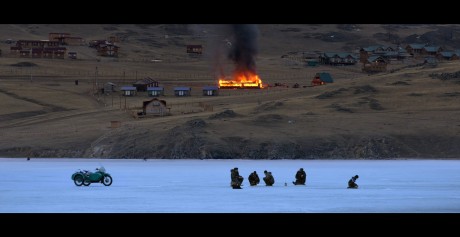


Viktor Kossakovsky: Aquarela

Normally when I go to an art exhibition, I walk around alone, stop in front of the paintings, it’s silent, maybe I talk with the one who are with me, but I love this chance of stepping into a world that does not move. When watching Kossakovsky’s flow of aquarelas, WATERcolors in constant movement, there is no silence, on the contrary – it’s a bombardment of image and sound, an aesthetic composition, it’s expressionistic, surrealistic, abstract, figurative, a journey through art directions and genres. And a magnificent piece of Cinema. That also has a dramaturgy.
As the director put it before the screening at the Pathé Munt 3 cinema in
Amsterdam at IDFA, the only cinema in Amsterdam that can play atmos dolby sound: Be prepared for a cold shower in the beginning, it will be warmer later on in the film. I agree with the first, I am not sure about the second.
Any way the overall theme is there right up front: You see ice and you see people moving around. From a respectful distance there is a focus on a man kneeling. He is looking for something in the water under the ice. Kneeling. The reference to praying is obvious. The sound from the ice is like a thunder, it’s bumps and bangs, a bit scary.
They are moving around, the men in their orange work suits, we spectators don’t know why, but we are told after the introduction of a burning house (PHOTO) with a mind blowing beautiful surrealistic layered image with a burning house: it’s about pulling up a car from under the ice! Shocking to watch, not because of the car but because the men fall on the ass one after the other, we fear it at the same time as we hope for it – and because of the sound of the film – a shock effect is sought for. The power of nature. We humans don’t stand a chance! A man was in a car, he seems to have drowned. Drama; a friend is crying out “he has drowned”.
A cold shower, indeed. And thanks for some calm moments under water, abstractions, and then suddenly a cute small goldfish comes into the picture. Before that strong heavy metal music, “I look at the world and I notice it’s turning. While my guitar gently weeps…” I was thinking of George Harrison afterwards, and then again a shock with a clip from a boat surrounded by meter high waves. Gosh!
The first part of the film with the crazy moments of cars underwater to be taken up is shot in Kamtjatka Russia, a Russian friend told me, the boat is sailing in the Atlantic Ocean. In other words, the film is far from informational National Geographic, it moves from place to place, from continent to continent. From painting to painting.
I love the sequences, where you rest your eye and can enjoy aquarelas, where the paint is thinned by the water, where it’s surrealism giving associations to Yves Tanguy or expressionism in the direction of Kandinsky or more wild like Jackson Pollock. These sequences have no purpose, they are invitations to contemplate the colors that suddenly turn to a black canvas; it’s a film with constant surprises.
For a Dane it felt calming to come to Greenland, to hear but not see the howling dogs, to see a boat go out with men on their way for hunting, I know about this from lots of films by late Danish director Jørgen Roos – and then back to the boat and the heavy metal music and the amazing images of two sailors steering safely – after the screening there was a question to Kossakovsky on how filming was on the boat: “we were lying fixed on the deck and it took us hours to get the tripod from one side of the ship to the other”.
Underwater again, we see a horse walking, not the head, it is above water. You smile, shake your head, it’s amazing what this director and cameraman gives you, what an image. Dali is of course associated to in my head and up we go to see herons walking in a cemetery, it’s a place where there is flood, we leave the icebergs for a moment to see water, it’s calm but interrupted it is by scary hurricane images from Florida (?), to waterfalls and sides of mountains – and Faces full of emotions “hidden” behind the waterfalls, close-ups, the only ones in a film, that is to be concluded by a rainbow and cello music. There is death in this film but also life and hope. An essay about the human condition. Faces held for a long time on the screen like in a film by Sokurov, to whom Kossakovsky has dedicated the film.
Wow!
UK, Germany, Denmark, 2018, 90 mins.